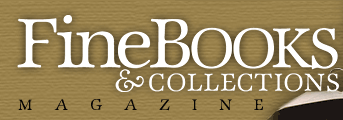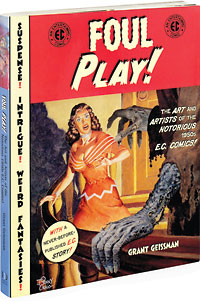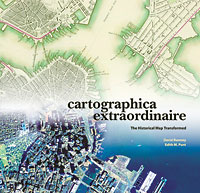| |
 |
 |
 |
|
BOOK REVIEWS
Foul Play!
 The Art and Artists of the Notorious 1950s E.C. Comics The Art and Artists of the Notorious 1950s E.C. Comics
By Grant Geissman
New York: Harper Design, 2005
272 pages. $29.95
ISBN 006074698X
One of the most significant art movements of the last
century didn’t occur in the academies of Europe or in the
universities and bohemian neighborhoods of American metropolises. It
occurred between the colorfully lurid covers of comic books
 One of the most significant
art movements of the last century didn’t occur in the academies of
Europe or in the universities and bohemian neighborhoods of American
metropolises. It occurred between the colorfully lurid
covers of comic books. The cramped sweatshops of comic-book publishers
produced a body of work that is enormously influential in contemporary
highbrow and popular culture. In their heyday, many adults dismissed comic
books as a waste of time at best and as a catalyst for juvenile delinquency
and depravity at worst. Yet, Roy Lichtenstein’s iconic
comic-book–inspired paintings sell for millions, Art
Spiegelman’s graphic novel about the holocaust, Maus, won a special Pulitzer Prize in 1992,
and Michael Chabon took home the fiction Pulitzer in 2001 for his rich
epic, The Amazing Adventures of Kavalier
& Clay, set in the comic-book world before
the Second World War. One of the most significant
art movements of the last century didn’t occur in the academies of
Europe or in the universities and bohemian neighborhoods of American
metropolises. It occurred between the colorfully lurid
covers of comic books. The cramped sweatshops of comic-book publishers
produced a body of work that is enormously influential in contemporary
highbrow and popular culture. In their heyday, many adults dismissed comic
books as a waste of time at best and as a catalyst for juvenile delinquency
and depravity at worst. Yet, Roy Lichtenstein’s iconic
comic-book–inspired paintings sell for millions, Art
Spiegelman’s graphic novel about the holocaust, Maus, won a special Pulitzer Prize in 1992,
and Michael Chabon took home the fiction Pulitzer in 2001 for his rich
epic, The Amazing Adventures of Kavalier
& Clay, set in the comic-book world before
the Second World War.
In the years after the war, E.C. Comics and its artists
became a profoundly influential cultural force. E.C. Comics
existed for only ten years. Its founder, Max C. Gaines, had midwifed
the comic-book medium in the 1930s. After seeing the success of
“premiums,” free color comic inserts that promoted consumer
products, Gaines bet that people would pay money for books of comic strips
and packaged the first modern comic book. He also encouraged a friend, DC
Comics publisher Harry Donenfeld, to publish a new, untried comic
feature called “Superman” in Action
Comics. The risk paid rich returns, spawned
numerous imitators, and launched the superhero comic-book industry.
In 1945, Gaines founded E.C. Comics, which published
“educational” comics (such as Picture
Stories from the Bible) and “entertaining” comics for young
readers (Animal Fables, Tiny Tot Comics). But a
success like Superman eluded him. Sales of E.C.’s titles were
tepid, and the company was in the red when Gaines died in an accident in 1947.
His son Bill Gaines, who was studying to be a chemistry teacher,
reluctantly took over the family business. He changed E.C.’s lines
from lackluster educational titles to eye-grabbing Western, romance, and
crime comics that aped more successful publishers. More important than
these changes, Gaines partnered with Al Feldstein, an aspiring
freelance writer and illustrator, and the two of them hired a stable of
unknown yet promising young artists: Harvey Kurtzman, Wallace Wood, Jack
Davis, and Al Williamson, among many others.
E.C.’s success didn’t last long. In 1954,
pseudo-psychologist Fredric Wertham published his book Seduction of the Innocent,
which claimed juvenile delinquency was caused by comic books. Wertham’s campaign
reached a crescendo when the U.S. Senate investigated the comic-book
industry. Gaines testified before a Senate subcommittee, which targeted
E.C. as the offender par exemplar. The comic-book publishers agreed to
regulate themselves with a Comics Code Authority, which approved comics
that could be sold on newsstands. This effectively killed all of
E.C.’s titles except one, MAD Magazine, which Gaines and his cohorts cultivated into an American
icon.
Foul Play! adequately
summarizes E.C.’s history, but most of the book is composed of brief
biographies of the personalities who produced E.C.’s finest work.
Each section generously includes photographs, illustrations, and ephemera
from their repertoire, and concludes with a reproduction of a complete E.C.
comic by the artist. Readers will recognize George Evan’s
“Blind Alleys” and Jack Davis’s “Foul Play,” still
quite ghoulish after fifty years. These stories and images have been anthologized
and imitated so many times in so many formats that the originals seem archetypical.
Other artists from E.C. are not as well-known but are
starting to get the interest they deserve. In the last few years,
Fantagraphics has published two coffee-table monographs, collecting and
analyzing the work of Bernie Krigstein, a brilliant artist and illustrator
who often seemed hampered by genre publications and limited budgets. He’s
represented in Foul Play! with an exquisitely illustrated version
of Ray Bradbury’s The Flying Machine and some rarely seen
illustrations and paintings.
Geissman also gives space for Marie Severin, colorist for E.C. and one of
the few women to hold a significant role in the comics world in the 1950s.
Unlike a lot of books that celebrate icons without
critical inquiry, Geissman doesn’t pull any punches, and includes the
politics, eccentricities, and failures that marked the tenure of these talents.
Their stories are as interesting as the ones they wrote. MAD Magazine was
an effort by Gaines to placate Kurtzman’s demands for more money. Their rivalry
made and nearly unmade the magazine and pushed Kurtzman toward more
ambitious projects, culminating in “Little Annie Fanny” for Playboy. Another fascinating E.C.
veteran is Graham Ingels, who left New York and comics behind to teach art,
only to reemerge from hiding two decades later.
Geissman is a signal example of the collector as
author. His previous books include Tales of
Terror! The E.C. Companion and Collectibly MAD, but writing
is a side gig. His day job is as a contemporary jazz guitarist and studio
musician. Yet Geissman displays little of the sloppy enthusiasm that often
mars fan-boy writing. The accompanying text isn’t a distraction;
it’s articulate, informative, and engaging. Foul Play! is
a thoughtfully assembled, beautifully reproduced labor of love, containing
a valuable history and rarely seen artifacts for collectors as well as readers
with a passing interest in pop culture.

The Historical Map Transformed
By David Rumsey and Edith M. Punt
Redlands, CA: ESRI Press, 2004
155 pages. $79.95
ISBN: 1589480449
When I show rare materials
to students and other groups, the maps we encounter often elicit
a collective indrawn breath, a palpable focusing of attention and scrutiny.
Collectors of maps have an intimate knowledge of this fascination, and
David Rumsey is clearly a map collector of the first rank. His collection
numbers more than 150,000 items, and he has placed 10,000 images of his
maps online (www.davidrumsey. com). As part of his continuing effort to bring the wealth of
his collection to the public, Rumsey has written a large-format book, Cartographica
Extraordinaire: The Historical Map Transformed, co-authored with Edith
Punt. It is both an exhibition catalog of highlights from his collection
and a thumbnail cartographic
history of the discovery, exploration, and development of the Americas from
roughly 1730 to 1930.
The goal of the book is to explore how cartography as
it was practiced in the past is important to the way maps are made today,
specifically to geographic information systems (GIS). According to Rumsey
and Punt, it is an “attempt to see the digital wizardry of GIS not as
a break from the past and old mapping traditions, but intrinsically and
essentially as part of those traditions, as another branch in a
family tree.” This goal is definitely achieved, both in general
and graphically, in the form of two digital maps. The most stunning is the
“Lewis and Clark Expedition 200th Anniversary Mosaic,” created
by digitally merging three maps: the central portion of Samuel
Lewis’s 1814 map, based on William Clark’s original drawing;
the General Land Office’s first complete land survey (circa 1870);
and a map from the 1970 United States Geological Survey
National Atlas. These three “layers” were then placed
over Landsat satellite imagery from NASA, creating a multilayered picture
of the expanding knowledge and development of the American West over
the course of two centuries. Although there is some distortion (the maps
are “georectified,” meaning that key geographical points are
matched up and the rest stretched to fit), it is an amazing and compelling
work of historical, contextual cartography.
More than 100 images of items in Rumsey’s
collection are depicted in this book with a loose narrative history of the
methods used in mapping and surveying America. At the end of the book, we
are treated to a few pictures of Rumsey’s library on the ground floor
of his home in San Francisco, including a nice panoramic view. The book is
fine example of how a great collection can enhance our
knowledge and understanding and is testament to the passions that objects
and artifacts can inspire.
|
|
|
